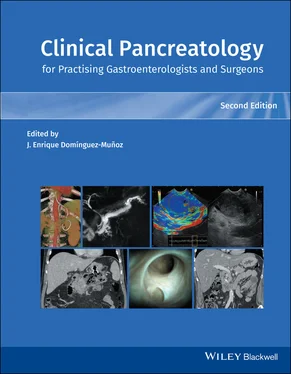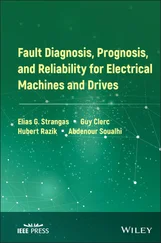30 Chapter 41Table 41.1 Variceal bleeding in CP patients with splenic vein thrombosis and ...
31 Chapter 44Table 44.1 Symptoms at diagnosis of autoimmune pancreatitis.Table 44.2 Other organ involvement in patients with autoimmune pancreatitis.
32 Chapter 46Table 46.1 Diagnostic algorithm for AIP: patients meeting criteria listed in ...
33 Chapter 48Table 48.1 Pancreatic enzyme replacement therapy formulations.Table 48.2 Pancreatic enzyme replacement therapy (PERT) dosing recommendation...Table 48.3 Dosing guidelines for oral, bolus, and continuous tube feeds.
34 Chapter 49Table 49.1 Estimated number of new pancreatic cancer cases and deaths in 2018...Table 49.2 Risk factors for pancreatic cancer: summary results of pooled anal...Table 49.3 Population attributable fraction (PAF) for potentially modifiable ...Table 49.4 Prediction of the pancreatic cancer incidence burden from the curr...
35 Chapter 52Table 52.1 Germline genetic mutations associated with pancreatic cancer.Table 52.2 Family history and risk of developing pancreatic cancer.Table 52.3 Screening recommendations.
36 Chapter 53Table 53.1 Biological markers in pancreatic cancer.
37 Chapter 54Table 54.1 The American Joint Committee on Cancer (AJCC) TNM Staging of Pancr...Table 54.2 Criteria defining resectability status.
38 Chapter 56Table 56.1 Reliability of EUS according to stage of pancreatic cancer.
39 Chapter 57Table 57.1 Strategies for performing EUS‐guided tissue acquisition in pancrea...
40 Chapter 59Table 59.1 ISGPS definitions of pancreatic surgery‐specific complications.Table 59.2 The fistula risk score and the alternative fistula risk score.Table 59.3 Severity grading of post‐pancreatectomy hemorrhage as provided by ...Table 59.4 ISGPS classification of post‐pancreatectomy hemorrhage (PPH).Table 59.5 ISGPS classification of delayed gastric emptying (DGE).Table 59.6 ISGLS classification of biliary leakage.Table 59.7 ISGPS classification of chyle leak.
41 Chapter 60Table 60.1 The AHPBA/SSO/SSAT classification and the MD Anderson classificati...Table 60.2 NCCN Pancreatic Adenocarcinoma Guidelines Version 3.2019 defining ...Table 60.3 Randomized clinical trials investigating neoadjuvant regimens in r...Table 60.4 Randomized phase I/II trials investigating neoadjuvant regimens in...
42 Chapter 61Table 61.1 Efficacy of adjuvant therapy over time and by chemotherapy regimen...
43 Chapter 62Table 62.1 Usual therapeutic dose of different antidepressant drugsTable 62.2 Usual analgesic drugs used for pancreatic cancer pain.
44 Chapter 63Table 63.1 Early endoscopic ultrasound celiac plexus neurolysis (EUS‐CPN) ver...
45 Chapter 64Table 64.1 Endoscopic palliation treatments for pancreatic cancer.
46 Chapter 66Table 66.1 Pancreatic exocrine insufficiency concepts elicited from qualitati...Table 66.2 Pancreatic exocrine insufficiency: frequency of concepts and sub‐c...
47 Chapter 67Table 67.1 Etiology of malnutrition in pancreatic cancer.Table 67.2 Long‐term nutritional complications of pancreatic resection.
48 Chapter 73Table 73.1 Areas of agreement and disagreement between the IAP, AGA and Europ...
49 Chapter 74Table 74.1 Classification of cystic neoplasms of the pancreas (including simi...
50 Chapter 75Table 75.1 Summary of EUS‐guided chemical ablation studies on CPL.
51 Chapter 76Table 76.1 Epidemiology and main clinical features of functioning pancreatic ...Table 76.2 2017 WHO classification of pancreatic neuroendocrine neoplasms (Pa...Table 76.3 European Neuroendocrine Tumor Society (ENETS) and American Joint C...
52 Chapter 78Table 78.1 Mechanisms which have been hypothesized to affect exocrine pancrea...Table 78.2 Algorithm for diagnosing, evaluating, and treating patients with s...
53 Chapter 79Table 79.1 Classification of diabetes mellitus.
54 Chapter 80Table 80.1 Proposed subclassification of pancreatogenic diabetes according to...Table 80.2 Advantages and disadvantages of diabetes medication classes in the...
1 Chapter 2 Figure 2.1 Investigative work‐up and treatment for patients with acute pancr...
2 Chapter 3 Figure 3.1 CECT showing acute interstitial edematous pancreatitis with acute... Figure 3.2 CECT showing a pancreatic pseudocyst more than four weeks after a... Figure 3.3 CECT showing acute necrotizing pancreatitis with an acute necroti... Figure 3.4 CECT showing walled‐off necrosis (WON) more than four weeks after...
3 Chapter 5 Figure 5.1 CT images of extrapancreatic necrosis and parenchymal pancreatic ... Figure 5.2 CT image of pancreatic pseudocyst shows a well‐encapsulated colle... Figure 5.3 Infected walled‐off necrosis: the arrow depicts the encapsulated ...
4 Chapter 6 Figure 6.1 A 44‐year‐old male presents with acute onset of severe abdominal ... Figure 6.2 A 61‐year‐old male referred from an off‐site institution due to a...
5 Chapter 9 Figure 9.1 Step‐up management of pain in acute pancreatitis. Non‐opioids suc...
6 Chapter 12 Figure 12.1 Pancreatic acinar cell focused AP treatment strategies. Physiolo... Figure 12.2 Strategies modulating pancreatic secretion. Cystic fibrosis tran... Figure 12.3 Immune system/anti‐inflammatory strategies. Inflammation in AP m...
7 Chapter 13 Figure 13.1 (a, b) Impacted stone at the level of the papilla. Figure 13.2 Role of endoscopic therapy in the setting of acute biliary pancr...
8 Chapter 14 Figure 14.1 CT scan of a patient with walled‐off necrosis (short arrows). Pr... Figure 14.2 CT scan of a patient with infected walled‐off necrosis after pla... Figure 14.3 Step‐up approach for the management of infected pancreatic necro...
9 Chapter 15 Figure 15.1 (a, b) Amplatz and dilatators used to dilate the drainage tract ... Figure 15.2 (a) Infected pancreatic necrosis by abdominal tomography. (b) Pl... Figure 15.3 Laparoscopic transperitoneal approach. (a) Location of the necro... Figure 15.4 Laparoscopic transgastric necrosectomy. (a) CT scan diagnoses a ...
10 Chapter 17 Figure 17.1 CT scan of 12‐cm collection causing a degree of gastric outflow ... Figure 17.2 CT scan showing LAMS in situ .
11 Chapter 18Figure 18.1 ERCP ( left ) and CT ( right ) in a patient with acute biliary pancr...
12 Chapter 19Figure 19.1 (a) Axial formatted venous phase CT scan from a patient presenti...Figure 19.2 (a) Pseudoaneurysm (arrow) in a pancreatic pseudocyst causing in...
13 Chapter 20Figure 20.1 Approach to etiological evaluation of recurrent acute pancreatit...Figure 20.2 Risk of progression from acute pancreatitis (AP) to recurrent ac...Figure 20.3 Interventions to prevent recurrent acute pancreatitis (RAP) and ...
14 Chapter 21Figure 21.1 Management of pancreatic enzyme replacement therapy and current ...
15 Chapter 22Figure 22.1 Rate of pancreatic abnormalities in patients with chronic asympt...Figure 22.2 Proposed diagnostic algorithm in patients with chronic asymptoma...
16 Chapter 23Figure 23.1 Progressive model of chronic pancreatitis development. This mode...
17 Chapter 25Figure 25.1 Effects of alcohol and its metabolites on the acinar cell, duct ...Figure 25.2 Smoking worsens alcoholic pancreatitis induced by alcohol and li...
18 Chapter 26Figure 26.1 Distinct scenarios when genetic association studies are conducte...
19 Chapter 27Figure 27.1 Pancreatogram in pancreas divisum (PD). (a) The pancreatogram sh...Figure 27.2 Prevalence of pancreas divisum (PD) is no greater in patients wi...
20 Chapter 28Figure 28.1 Diagnosis of chronic pancreatitis: an algorithm for clinical pra...
21 Chapter 29Figure 29.1 The different patterns of chronic pancreatitis. (a) Coronal CT o...Figure 29.2 A 58‐year‐old man with chronic calcifying pancreatitis. (a) CT v...Figure 29.3 Abdominal CT with dual‐energy source (80 and 140 kV) in a 46‐yea...Figure 29.4 Perfusion CT of the healthy pancreas of a 53‐year‐old patient. (...
Читать дальше












